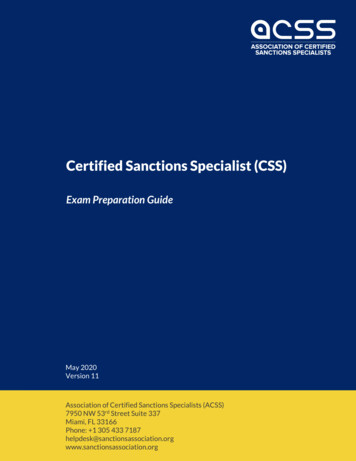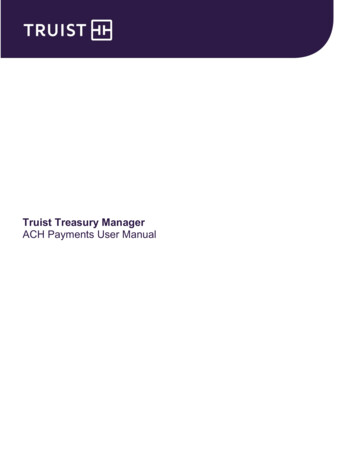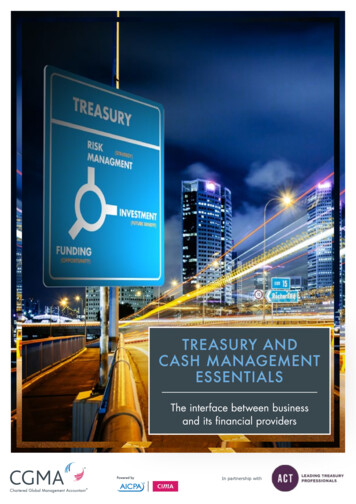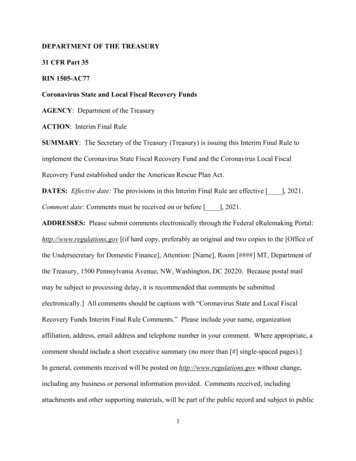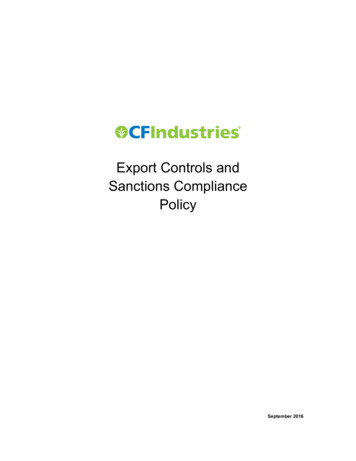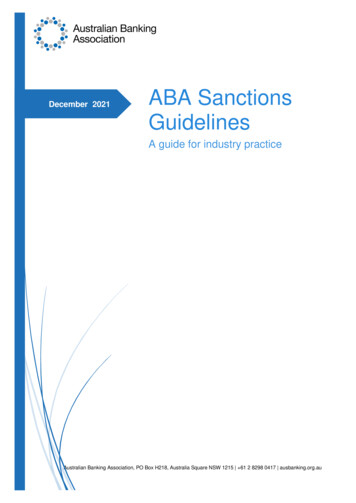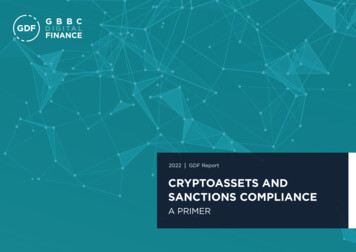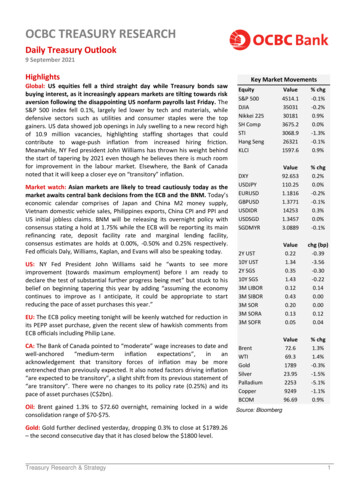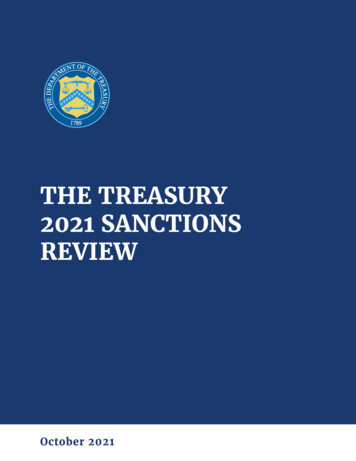
Transcription
THE TREASURY2021 SANCTIONSREVIEWOctober 2021
THE TREASURY 2021 SANCTIONS REVIEW1After the September 11, 2001 attacks, economic and financial sanctions (“sanctions”) became a toolof first resort to address a range of threats to the national security, foreign policy, and economy of theUnited States. This tool rests on the formidable strength of, and trust in, the U.S. financial system andcurrency. At their core, sanctions allow U.S. policymakers to impose a material cost on adversariesto deter or disrupt behavior that undermines U.S. national security and signal a clear policy stance.Treasury’s work on sanctions is conducted in close partnership with other parts of the ExecutiveBranch, in particular the Department of State and the National Security Council, which lead theformulation of the foreign policy and strategic goals that sanctions serve, as well as the Departmentof Justice. The Department of State also implements certain sanctions authorities in consultation withthe Treasury.Over the last 20 years, the Department of the Treasury (Treasury), in close coordination with theDepartment of State, has successfully employed sanctions to address various national securitychallenges, including: Preventing Iran from using the international financial system and commercial markets togenerate revenue through oil sales and other activities that support its nuclear and ballisticmissile proliferation and support for terrorist activities. These sanctions pushed Iran to thenegotiating table on its nuclear program in 2015. In coordination with U.S. and foreign law enforcement action, freezing2 and seizing billions ofdollars in assets from front companies used by the Cali Cartel (at one point the world’s largestdrug trafficking organization), culminating in the 2014 dismantling of the cartel and the arrestand imprisonment of its leaders. Protecting tens of billions of dollars in Libyan assets from misappropriation by formergovernment officials following civil unrest and the fall of the Qadhafi regime in 2011. Designating over 1,600 terrorist entities and individuals since 9/11, targeting, exposing, andundermining terrorist groups and their operations. For example, U.S. sanctions so significantlyimpaired Hizballah funding streams that in 2019 the organization had to reduce salaries for itsmilitary arm and media efforts and publicly solicit donations.1 This document is explanatory only and does not have the force of law. It does not modify statutory authorities, Executiveorders, regulations, or regulatory guidance. It is not intended to be, nor should it be interpreted as, comprehensive, or asimposing requirements under U.S. law, or otherwise addressing any requirements under applicable law. It is not intended to,and does not, create any right or benefit, substantive or procedural, enforceable at law or in equity by any party against theUnited States, its departments, agencies, or entities, its officers, employees, or agents, or any other person.2 The primary impact of adding individuals and entities to Treasury’s Office of Foreign Assets Control (OFAC)’s List of SpeciallyDesignated Nationals and Blocked Persons (“the SDN List”) is that their property and interests in property are blocked.When property is blocked (or “frozen”), title to the blocked property remains with the owner of the property and any fundsconstituting or arising from blocked property must be placed into a blocked, interest-bearing account at a U.S. financialinstitution. Blocking immediately imposes an across-the-board prohibition against transfers or dealings of any kind withregard to the property. The exercise of powers and privileges normally associated with ownership of blocked property isprohibited without authorization from OFAC.THE TREASURY 2021 SANCTIONS REVIEW1
When used effectively, sanctions have the capacity to disrupt, deter, and prevent actions thatundermine U.S. national security. However, the United States now faces new, emerging challenges tothe efficacy of sanctions as a national security tool: cybercriminals; strategic economic competitors;and a workforce and technical infrastructure under pressure from growing financial complexityand competing demands from policymakers, market participants, and others. To ensure sanctionscontinue to support U.S. national security objectives, the U.S. government must adapt and modernizethe underlying operational architecture by which sanctions are deployed.These changes are also needed to keep pace with the evolution of the global financial architecture,which has a profound impact on the efficacy of U.S. financial sanctions. American adversaries—andsome allies—are already reducing their use of the U.S. dollar and their exposure to the U.S. financialsystem more broadly in cross-border transactions. While such changes have multiple causes beyondU.S. financial sanctions, we must be mindful of the risk that these trends could erode the effectivenessof our sanctions.In addition, technological innovations such as digital currencies, alternative payment platforms, andnew ways of hiding cross-border transactions all potentially reduce the efficacy of American sanctions.These technologies offer malign actors opportunities to hold and transfer funds outside the traditionaldollar-based financial system. They also empower our adversaries seeking to build new financial andpayments systems intended to diminish the dollar’s global role. We are mindful of the risk that, if leftunchecked, these digital assets and payments systems could harm the efficacy of our sanctions.“ I do seriously think we have a responsibility to use sanctions for important nationalsecurity issues. But we need to think about the long-term impact on the global currency.”2- Former Secretary of the Treasury Steven MnuchinTHE TREASURY 2021 SANCTIONS REVIEW
As part of a 2021 review of its economic and financial sanctions, Treasury met with individualsrepresenting hundreds of sanctions stakeholders, including Members of Congress and their staffs,interagency partners, the private sector, foreign governments, nongovernmental organizations,academics, and Treasury’s sanctions workforce. The review focused on two primary issues: (1) theframework guiding imposition of economic and financial sanctions and (2) potential operational,structural, and procedural changes to improve Treasury’s ability to use sanctions now and in the future.This review was neither an assessment of each of the 37 existing sanctions programs3 administeredand enforced by the Office of Foreign Assets Controls (OFAC), and the over 12,000 OFAC designationsand nearly 3,000 OFAC delistings, nor a full examination of all economic statecraft tools. In addition,the review did not include separate sanctions authorities implemented by the Department of State orother restrictive measures implemented by other Departments and Agencies, such as visa restrictionsor export controls.The objective of this review was to ensure that economic and financial sanctions remain an effective toolof U.S. national security and foreign policy now and in the future. This report incorporates highlights fromstakeholder perspectives as well as data and recommendations for improving Treasury’s implementationof sanctions. It offers several steps to modernize sanctions to address current policy priorities and keepthe tool sufficiently nimble to address future threats. These steps include:3 There are multiple statutory or executive authorities (allowing for the imposition of sanctions based on certain criteria) ineach sanctions program. Sanctions are most commonly issued pursuant to Presidential authorities that the President hasdelegated to Treasury in certain scenarios. Treasury implements those sanctions pursuant to criteria provided in both theunderlying statute and the relevant Presidential delegations.THE TREASURY 2021 SANCTIONS REVIEW3
Steps to Modernize Sanctions1. Adopting a structured policy framework that links sanctions to a clear policy objectiveEconomic and financial sanctions should be tied to clear, discrete objectives that are consistent withrelevant Presidential guidance—such as countering forces that fuel regional conflict, ending supportto a specific violent organization or other malign and/or illicit activities, stopping the persecution of aminority group, curtailing nuclear proliferation activities, enhancing multilateral pressure, or ceasingspecific instances of atrocities. To accomplish this, Treasury will adopt the use of a structured policyframework in order to inform its recommendations on the use of sanctions. This framework shouldreflect key policy considerations and ask whether a sanctions action:a) Supports a clear policy objective within a broader U.S. government strategy: Sanctions shouldbe deployed alongside other measures as part of a larger strategy in support of specific policyobjectives.b) Has been assessed to be the right tool for the circumstances: Sanctions should incorporaterigorous economic analysis, technical expertise, and intelligence to ensure that they are the righttool in our national security arsenal to pursue the identified objective.c) Incorporates anticipated economic and political implications for the sanctions target(s), U.S.economy, allies, and third parties and has been calibrated to mitigate unintended impacts:Sanctions should be designed to tailor their impact so that costs fall on intended targets and thatpotential negative impact on others is minimized.d) Includes a multilateral coordination and engagement strategy: Where possible, sanctionsshould be coordinated with allies, incorporating shared intelligence and resources, andaccompanied by engagement with relevant stakeholders including industry, financial institutions,allies, civil society, and the media.e) Will be easily understood, enforceable, and, where possible, reversible: Sanctions shouldbe clearly communicated so that targets, allies, and others understand their specific objectivesand the circumstances under which they may be escalated or reversed in response to the target’sbehavior.The consistent application of this sanctions policy framework will establish clear criteria for the use ofsanctions. Treasury should also seek to develop and implement an analytical construct to assess itssanctions programs and actions systematically, incorporating this policy framework and building onexisting evaluation efforts. The product of these assessments could be recommendations to augment,adapt, or wind down individual authorities or to list or delist particular individuals or entities.“ We must guard against the impulse to reach for sanctions too lightly or in situations wherethey have negligible impact.”4– Former Secretary of the Treasury Jack LewTHE TREASURY 2021 SANCTIONS REVIEW
2. Incorporating multilateral coordination, where possibleSanctions are most effective when coordinated as an Administration with allies and partners whocan magnify economic and political impact. This coordination also enhances the credibility ofU.S. international leadership and shared policy or security goals of the United States and its allies.Coordinated actions also help mitigate the economic impact on American workers and firms. Alliesand partners can be encouraged to coordinate sanctions policy through: (1) collaboration and sharingof policy frameworks and information; (2) ongoing efforts to harmonize sanctions regimes; and (3)efforts to build sanctions coordination into existing multilateral fora. These multilateral efforts includeadvocating for UN sanctions when possible and appropriate to ensure global applicability of restrictivemeasures and amplify messaging, as well as working through other multilateral organizations. TheState Department, in particular, as the U.S. Government interagency lead for the formulation of foreignpolicy, is an essential partner and leader in this work.3. Calibrating sanctions to mitigate unintended economic, political, and humanitarian impactTreasury should seek to tailor sanctions in order to mitigate unintended economic and politicalimpacts on domestic workers and businesses, allies, and non-targeted populations abroad. This willprotect key constituencies and help preserve support for U.S. sanctions policy. For example, U.S. smallbusinesses may lack the resources to bear the costs of sanctions compliance while competing withlarge companies at home and abroad; uncalibrated sanctions could unnecessarily lead them to turndown business opportunities in order to avoid these costs. Better tailored sanctions can help avoidthese costs and maintain the competitiveness of U.S. businesses.In addition, Treasury must address more systematically the challenges associated with conductinghumanitarian activities through legitimate channels in heavily sanctioned jurisdictions. Wherepossible and appropriate, Treasury should expand sanctions exceptions to support the flow oflegitimate humanitarian goods and assistance and provide clear guidance at the outset whensanctions authorities are created and implemented, particularly related to vulnerable populations.Going forward, Treasury will continue to review its existing authorities to consider the unintendedconsequences of current sanctions regimes on humanitarian activity necessary to support basichuman needs, as well as potential changes to address them while continuing to deny support tomalicious actors. We believe this effort is worthy of significant time and effort to ensure the worldunderstands that the provision of legitimate humanitarian assistance reflects American values.4. Ensuring sanctions are easily understood, enforceable, and adaptableSanctions are only as effective as their implementation, especially with regard to communicationand engagement. In order to better calibrate the use of this tool, Treasury needs to communicate andcoordinate more effectively with stakeholders affected by the use of financial sanctions. Treasury canbuild on existing outreach and engagement capabilities through enhanced communication with industry,financial institutions, allies, civil society, and the media, as well as new constituencies, particularly in thedigital assets space.THE TREASURY 2021 SANCTIONS REVIEW5
Treasury should enhance its public messaging and engagement with key audiences domestically andinternationally around its sanctions, ensuring that the messaging augments and closely aligns with keystakeholder groups. It should also coordinate closely with the Department of State on messaging forforeign engagement. Enhancing the public information on the Treasury website and communicating inplain language would also improve public understanding of the intent and effect of sanctions.5. Investing in modernizing Treasury’s sanctions technology, workforce, and infrastructureModernization requires investing in Treasury’s sanctions workforce and operational capabilities. TheDepartment must have the right expertise, technology, and staff to support a robust and effectivesanctions policymaking and implementation process. These investments will sustain Treasury’s abilityto execute a core tool of U.S. foreign policy and national security, protect the integrity of the U.S.financial system, and build on constructive relationships with a wide array of sanctions stakeholders.In particular, Treasury should invest in deepening its institutional knowledge and capabilities in theevolving digital assets and services space to support the full sanctions lifecycle of activities.To better facilitate compliance, Treasury should expand its use of technology to provide criticalinformation to domestic and foreign audiences affected by sanctions actions. This includes makingcertain tactical and operational improvements. For example, stakeholders reported that Treasury’spublic website is viewed as cumbersome to navigate, and could be improved to offer clearer guidanceto better support humanitarian groups and regulated entities, as well as sanctions targets themselves.All of these steps must be taken in close coordination with the National Security Council, Departmentof State, U.S. Agency for International Development, Department of Justice, and other interagencypartners. Sources of sanctions authorities continue to come from both Congress and executiveorders, and those sources set out authorities, vested often in the President and delegated mainly tothe Treasury and the Department of State, as well as other federal agencies in some cases. Notably,6THE TREASURY 2021 SANCTIONS REVIEW
the Department of State administers and helps implement numerous sanctions authorities andholds a leading role among federal agencies in setting the foreign policy agenda pursued throughU.S. sanctions. As Treasury pursues these recommendations, especially reinforcing a commitmentto multilateral coordination, it is essential that the Departments of the Treasury, State, and otheragencies continue and enhance their strong partnership and close coordination to advance U.S.government policy objectives and national security.***The United States faces a changing world where financial innovation, shifts in global economic activity,and new geopolitical challenges are redefining how economic power can be used to support nationalsecurity objectives. These shifts are accompanied by new and rising threats for which sanctionsmay be a critical tool of U.S. policy. To effectively confront these changes, Treasury must modernizeand adapt its sanctions policy and operational framework. A refined policy rubric and options formodernizing Treasury’s sanctions infrastructure will provide Treasury with the right tools to stayahead of these changes and the adversaries seeking to take advantage of them. Though it will requireTreasury, and others in the U.S. government, to make difficult decisions about where and when torecommend the use of sanctions, doing so will ultimately strengthen Treasury’s use of sanctionsin the long-term. These changes will lay the groundwork for future Treasury leadership to addresstomorrow’s challenges.THE TREASURY 2021 SANCTIONS REVIEW7
The review focused on two primary issues: (1) the framework guiding imposition of economic and financial sanctions and (2) potential operational, structural, and procedural changes to improve Treasury's ability to use sanctions now and in the future. This review was neither an assessment of each of the 37 existing sanctions programs3 administered


